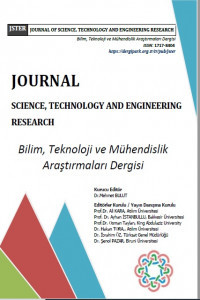Kalınlık, Doping ve Hata Yoğunluğu Kontrolü Yoluyla Kurşunsuz CH3NH3SnI3 Perovskite Güneş Pillerinin Performansını Optimize Etme
Perovskite güneş pilleri, Fotovoltaik performans, Üretim süreci, Kurşunsuz perovskite, Sayısal simülasyon.
Optimizing the Performance of Lead-free CH3NH3SnI3 Perovskite Solar Cells via Thickness, Doping, and Defect Density Control
Perovskite solar cells, Photovoltaic performance, Manufacturing process, Lead-free perovskite, Numerical simulation.,
___
- [1] Lee, K., Kim, H., & Park, N. G. (2012). High-performance photovoltaic perovskite layers fabricated through intramolecular exchange. Science, 338(6107), 643-647.
- [2] Tan, Z., Zhao, N., & Wu, J. (2016). Efficient and stable perovskite solar cells: a review. Renewable and Sustainable Energy Reviews, 57, 1119-1129.
- [3] Mitzi, D. B., Park, N. G., & Osgood, R. M. (2014). High-efficiency hybrid photovoltaic perovskites. Nature Materials, 13(9), 873-880.
- [4] Ye, L., Li, Y., & Chen, L. (2017). Tin-based hybrid perovskites for photovoltaic applications. Advanced Energy Materials, 7(7), 1603441.
- [5] P. K. Patel, “Device simulation of highly efficient eco-friendly CH3NH3SnI3 perovskite solar cell,” Sci. Rep., vol. 11, pp. 1–11, 2021, doi: 10.1038/s41598-021-82817-w.
- [6] P.Sun, Q.Li, and L.Yang, “Theoretical insights into a potential lead-free hybrid perovskite: substituting Pb2+ with Ge2+,” Nanoscale, p. 10, 2015, doi: 10.1039/C5NR05337D.
- [7] M. Burgelman, “SCAPS manual,” 2020.
- [8] L. Yang, A. T. Barrows, and D. G. Lidzey, “Device simulation of lead-free CH 3 NH 3 SnI 3 perovskite solar cells with high efficiency,” vol. 25, p. 10, 2016, doi: 10.1088/1674-1056/25/10/108802.
- [9] Y. M. Lee, I. Maeng, J. Park, M. Song, and J. Yun, “Comprehensive Understanding and Controlling the Defect Structures : An Effective Approach for Organic-Inorganic Hybrid Application,” vol. 6, no. November, pp. 1–9, 2018, doi: 10.3389/fenrg.2018.00128.
- [10] Ozkaya, U., & Seyfi, L. (2016). Modeling and Analysis of Absorbing Boundary Condition in Antenna Design. In CBU International Conference Proceedings (Vol. 4, pp. 832-839).
- [11] M. Burgelman, “SCAPS manual,” 2020.
- [12] C.Asma, “Optimisation et simulation numérique du profilde la couche absorbante et des différentes couches.”
- [13] C.Meriem, “Optimization by simulation of the nature of the buffer, the gap profile of the absorber and the thickness of the various layers in CZTSSe solar cells,” pp. 0–30, 2017.
- [14] P. K. Patel, “Device simulation of highly efficient eco-friendly CH3NH3SnI3 perovskite solar cell,” Sci. Rep., vol. 11, pp. 1–11, 2021, doi: 10.1038/s41598-021-82817-w
- Başlangıç: 2020
- Yayıncı: Mehmet BULUT
Soğuk İşlemle (CW) İşlenen AA 6061 T6 Alüminyum alaşımının Mekanik Özelliklerinin Gelişimi
Studied the Impact of the Foundation on the Underground Cavity Using the Finite Element Method
Hosni Abderrahmane TALEB, Ismahene GUEMIDI
A Review of State-of-the-Art Techniques for Power Flow Analysis
Alıyu SABO, Kamaluddeen IBRAHIM KANYA, Nazıru SHU'AIBU, Chıgozıe ONYEMA, Ahmed ALIYU, Hadıza TANKO, Sama'ıla KWASAU
Betül ŞAHİN, Başak ÜNVER KOLUMAN, Mücahit SEÇME, Yavuz DODURGA, Gülçin ABBAN METE, Mustafa KÖSE, Mahmed Sari NJJAR, Ahmet KOLUMAN
Yumuşak zeminde tünel kazısının 3 boyutlu simülasyonu
Kompozit Levhaların Tamirinde Yama Özelliklerinin Çekme Gerilme Davranışlarına Etkisi
